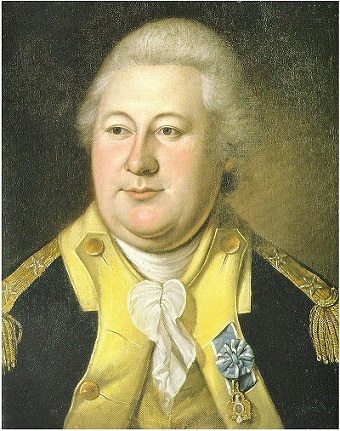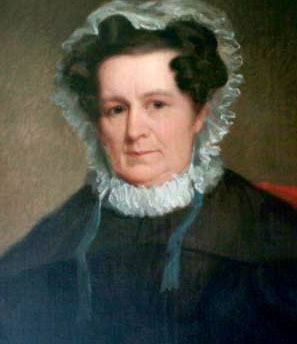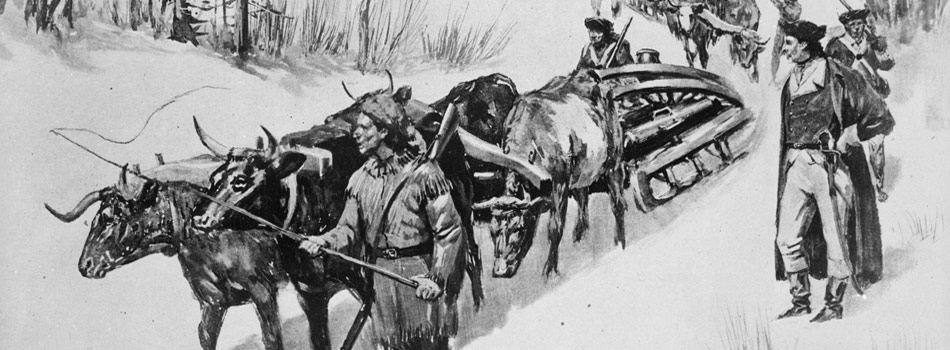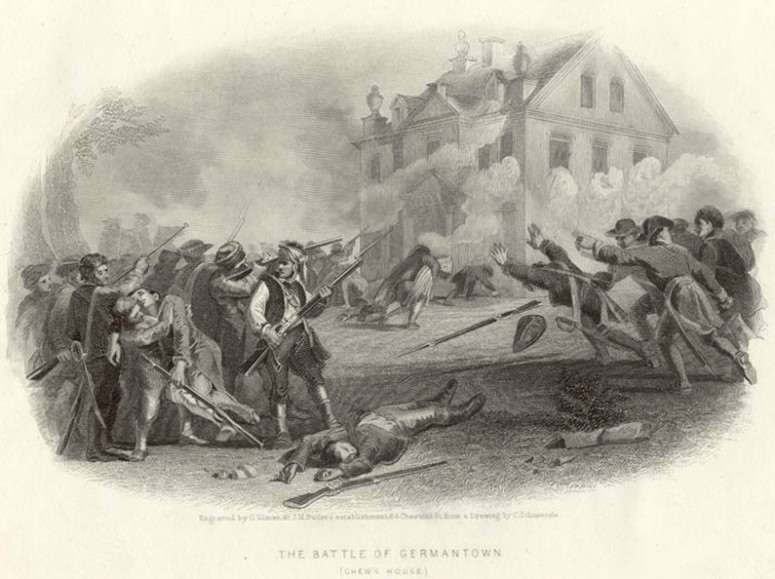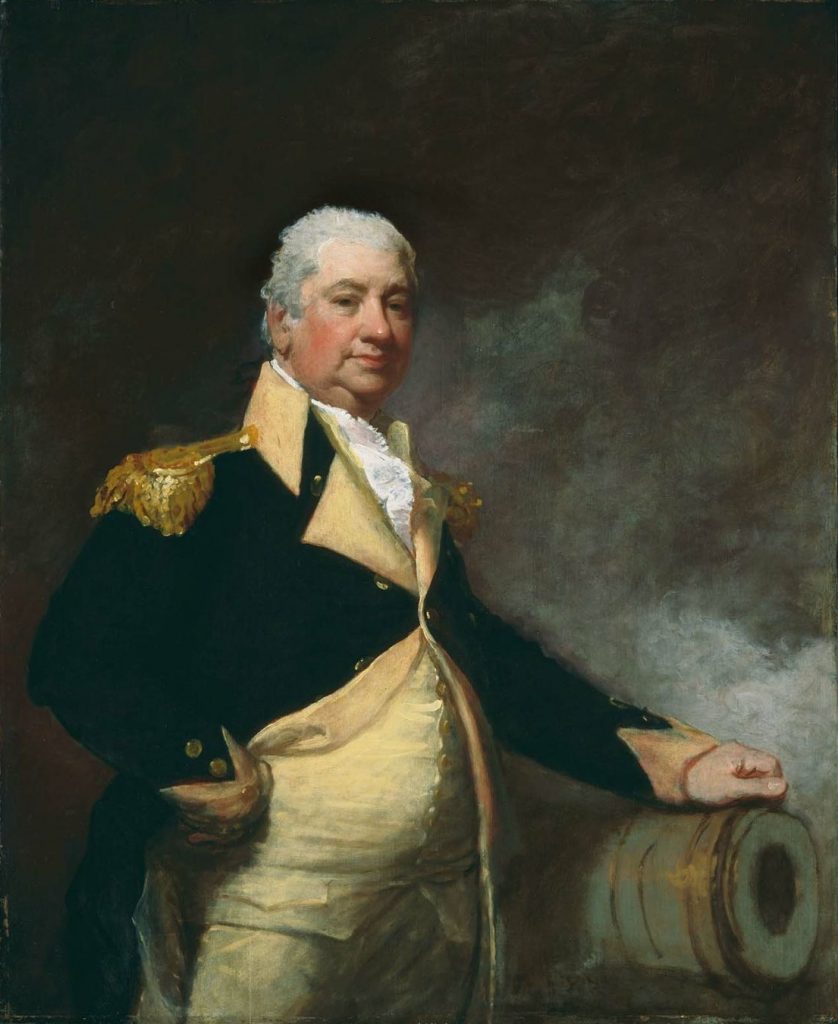General Henry Knox was a close friend of George Washington’s, and the first Secretary of War. Knox quickly became the chief artillery officer of the Continental Army. By the end of the war, he held the rank of a major general after participating in many major and critical battles.
On July 25, 1750, Henry Knox was born to parents William and Mary Knox in Boston, Massachusetts. Of their ten children, only their three youngest survived (Henry, William, and Jane Dolloff). Because of financial problems with his shipbuilding business, William left his family for the West Indies. Knox dropped out of the Boston Latin School at twelve years old to work in a bookshop to support his family. Eventually, Knox went on to open a bookshop of his own, the London Book Store, when he was twenty-one. He read extensively on the subject of war, focusing mainly on artillery. Knox even taught himself French so he could read books on the subject that had not yet been translated.
Lucy Flucker, at seventeen, began visiting his bookshop often. While Knox had been born into poverty, Lucy was born into aristocracy. Despite her Loyalist parents protests that she marry a man born into wealth like herself, Lucy had her mind set on Knox. Shortly before her eighteenth birthday, Lucy married the twenty-three year old Henry Knox on June 16, 1774. The couple had a happy marriage with thirteen children, though only Henry Jackson, Lucy Flucker, and Caroline Flucker Knox survived to adulthood. Shortly after the war broke out in 1775, the two quickly fled Boston. During the war, Lucy was constantly having to move around and stay with friends or family, but preferred to be at camp with her husband.
In 1772, Knox had volunteered and joined the Boston Grenadier Corps. After spending years of reading on war, Knox was eager to join. He was given the rank of first lieutenant, or second in command. He had earlier been a witness to the Boston Massacre and may have even participated in the Boston Tea Party. It is unknown if he did or not, but he was on guard duty shortly before it happened. Knox was an avid supporter of the Sons of Liberty as well.
The war broke out in April of 1775, and Knox was forced to flee his home with his wife. Knox quickly joined the militia army when the siege of Boston began. Serving under General Artemas Ward, Knox developed fortifications around the city and directed rebel cannon fire during the Battle of Bunker Hill. Upon arriving in Boston that July, General George Washington took an immediate liking to Knox, impressed by all he had done during the Battle of Bunker Hill.
After Fort Ticonderoga had been captured, Knox suggested that the cannons at the fort could have a decisive impact. Knox was commissioned by Washington as a colonel and was sent on an expedition to retrieve the cannons. An ox-drawn sled hauled the sixty tons of cannons over ice-covered rivers and snowy mountains all the way back to Boston, amounting to be about 300 miles. It is now known today as the noble train of artillery, or the Knox Expedition. Knox had originally estimated the journey would take two weeks, but ended up lasting 56 days, between December 5, 1775 and January 24, 1776. On March 17, 1776, the British finally left Boston for Halifax after the cannons had been placed overlooking Boston, threatening the British troops.
With the Siege of Boston over after more than ten months, Knox got to work on improving Connecticut, Rhode Island, and New York’s defenses. While in New York, Knox met and befriended Alexander Hamilton, who he would stay close with until Hamilton died. Benjamin Lincoln also held a close friendship with Knox during the war.
During the New York and New Jersey Campaign, Knox stayed with Washington’s army. Knox was nearly captured in the British invasion of Manhattan, but was able to just barely escape with the help of Aaron Burr. In the crossing of the Delaware River, Knox was put in charge of the logistics. He was able to get men, horses, and artillery across the river safely. After the Battle of Trenton on December 26, 1776, Knox was promoted to the rank of a brigadier general for all he had done during and before the battle. Knox fought in the Battle of Assunpink Creek and the Battle of Princeton that January.
Soon, Knox made his way back to Massachusetts while the army was stationed at Morristown, New Jersey in the winter of 1777. While in Massachusetts, Knox worked hard so that the Army’s artillery manufacturing capability was improved. Not only that, but Knox also established an armory in Springfield, Massachusetts and raised a battalion of artillerymen. He returned to Morristown afterwards, and his armory proved to be very valuable during the war.
When French soldier Philippe Charles Tronson du Coudray was appointed to command the artillery, Knox was furious and upset, threatens congress that he would resign. Du Coudray’s appointment upset many others, John Sullivan and Nathanael Greene included, who protested it. Instead, du Coudray was given the role of inspector general, but died shortly after during that September.
Knox was present at the Battle of Brandywine that took place during the Philadelphia Campaign in 1777. Before the Battle of Germantown, Knox had suggested to Washington that they capture the Chew House instead of bypassing it like they had planned. The Chew House was a mansion that the British had been occupying. However, this only helped the British, and they won the battle. After the Battle of Monmouth, Washington even commended Knox for the artillery’s performance.
In the winter of 1778, Knox established the first school for artillery and officer training under the Continental Army. Knox spent the summer of 1779 training over 1,000 soldiers. Previously, Knox had also established the Pluckemin Continental Artillery Cantonment Site in New Jersey in 1778.
When Major John André was convicted for assisting Benedict Arnold on spying on the Continental Army, Knox served as a court martial. He continued to help out Washington by traveling north to get more men and supplies. Knox then fought during the Siege of Yorktown on that had began on September 25, 1781 and lasted until October 19th. He was notably active on the field, and Washington recommended to Congress that they promote Knox after Yorktown.
On March 22, 1782, Knox was promoted to the rank of a major general, becoming the youngest major general in the Continental Army. With Gouverneur Morris, Knox negotiated prisoner exchanges with British officers. Their negotiations failed, and Knox returned to join the army in Newburgh, New York. He worked to inspect West Point’s conditions and was appointed by Washington as the commander of West Point in August of 1782. Shortly after, Knox fell into a state of depression when his nine month old son had passed away. Knox attempted negotiating with the Confederation Congress on soldiers’ compensation, but Congress was not willing to further negotiations. Knox wrote a warning letter, which led to Washington holding a meeting the following March. From then on, Knox was a firm believer that the United States have a stronger federal government.
Washington resigned from his post as Commander-in-Chief of the continental Army at the end of the war in December of 1783. Knox took over, becoming Senior Officer of the United States Army. Earlier that year in November, Benjamin Lincoln had resigned from his post as Secretary at War. Knox established the Society of the Cincinnati on May 13, 1783. In 1784, Knox resigned from the army.
Now that the war was over, Knox and his family returned to Massachusetts and established a home in Dorchester. Lucy’s parents had land in Maine that had been confiscated from them, and Knox went to work to reassemble their land. He assembled a multi-million acre piece of land in Maine.
Knox became Secretary at War on March 8, 1785 after Congress had spent a long period of time deciding on a candidate. By then, the army was much smaller than it had been before. That same year, Congress established an army with only 700 men. Knox proposed that a military academy be established, but many opposed the idea of having one when the country was not at war. He also proposed an army that mainly consisted of state militia.
When the Constitution was awaiting state ratification, Knox became an avid supporter of the new document and government. Many even saw him as a good candidate for vice-president, but Knox stayed in the War Department, becoming the first United States Secretary of War under the Constitution on September 12, 1789.
Now that he was the Secretary of War, Knox was responsible for the Militia Act of 1792 and worked hard to evaluate arms and the readiness of the militia. He quickly realized that only 20% of the militia’s 450,000 men were capable of arming themselves when needed. Upon realizing this, Knox recommended to Congress that they should purchase more imported weapons and ban exportation of weapons produced in the U.S. Knox also recommended they establish facilities to produce and stockpile weapons. During his time as Secretary of War, Knox was also responsible for relations with Native Americans.
On January 2, 1795, Knox resigned from his post and joined his growing family in Thomaston, Massachusetts (now in Maine). Timothy Pickering succeeded him as the new Secretary of War. When he arrived home, Knox had a three story mansion built that they called Montpelier in Thomaston. For years he was engaged in business at his home and entertained many guests with Lucy. In 1805, Know was elected a Fellow of the American Academy of Arts and Sciences and attempted to make even more money and growing his fortune. This led to him building up deep debts.
Knox was visiting one of his close friends in the fall of 1806, when he swallowed a chicken bone. The bone got lodged in his throat which led to a bad infection. Three days later, Henry Knox died on October 25, 1806 at his Montpelier estate. He was also buried there. Lucy later died eighteen years later in 1824 after paying off Knox’s debts by selling off portions of their estate. The estate was later demolished in 1871, but a museum resembling the estate was later built.


